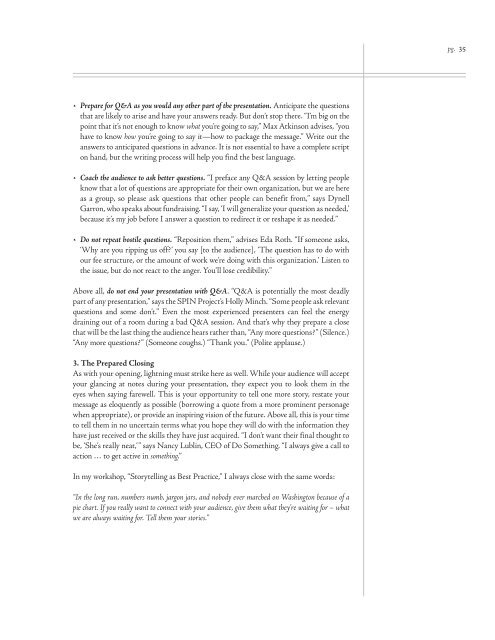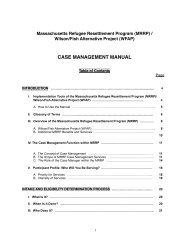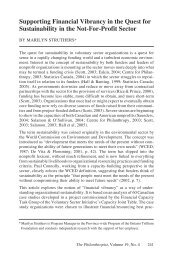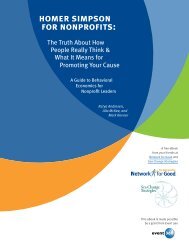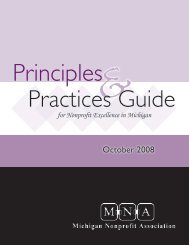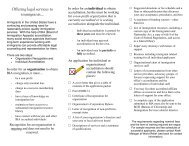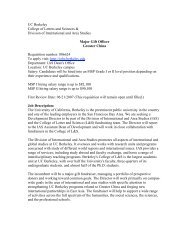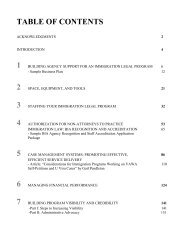Why Bad Presentations Happen to Good Causes - The Goodman ...
Why Bad Presentations Happen to Good Causes - The Goodman ...
Why Bad Presentations Happen to Good Causes - The Goodman ...
Create successful ePaper yourself
Turn your PDF publications into a flip-book with our unique Google optimized e-Paper software.
• Prepare for Q&A as you would any other part of the presentation. Anticipate the questions<br />
that are likely <strong>to</strong> arise and have your answers ready. But don’t s<strong>to</strong>p there. “I’m big on the<br />
point that it’s not enough <strong>to</strong> know what you’re going <strong>to</strong> say,” Max Atkinson advises, “you<br />
have <strong>to</strong> know how you’re going <strong>to</strong> say it—how <strong>to</strong> package the message.” Write out the<br />
answers <strong>to</strong> anticipated questions in advance. It is not essential <strong>to</strong> have a complete script<br />
on hand, but the writing process will help you find the best language.<br />
• Coach the audience <strong>to</strong> ask better questions. “I preface any Q&A session by letting people<br />
know that a lot of questions are appropriate for their own organization, but we are here<br />
as a group, so please ask questions that other people can benefit from,” says Dynell<br />
Garron, who speaks about fundraising. “I say, ‘I will generalize your question as needed,’<br />
because it’s my job before I answer a question <strong>to</strong> redirect it or reshape it as needed.”<br />
• Do not repeat hostile questions. “Reposition them,” advises Eda Roth. “If someone asks,<br />
‘<strong>Why</strong> are you ripping us off?’ you say [<strong>to</strong> the audience], ‘<strong>The</strong> question has <strong>to</strong> do with<br />
our fee structure, or the amount of work we’re doing with this organization.’ Listen <strong>to</strong><br />
the issue, but do not react <strong>to</strong> the anger. You’ll lose credibility.”<br />
Above all, do not end your presentation with Q&A. “Q&A is potentially the most deadly<br />
part of any presentation,” says the SPIN Project’s Holly Minch. “Some people ask relevant<br />
questions and some don’t.” Even the most experienced presenters can feel the energy<br />
draining out of a room during a bad Q&A session. And that’s why they prepare a close<br />
that will be the last thing the audience hears rather than, “Any more questions?” (Silence.)<br />
“Any more questions?” (Someone coughs.) “Thank you.” (Polite applause.)<br />
3. <strong>The</strong> Prepared Closing<br />
As with your opening, lightning must strike here as well. While your audience will accept<br />
your glancing at notes during your presentation, they expect you <strong>to</strong> look them in the<br />
eyes when saying farewell. This is your opportunity <strong>to</strong> tell one more s<strong>to</strong>ry, restate your<br />
message as eloquently as possible (borrowing a quote from a more prominent personage<br />
when appropriate), or provide an inspiring vision of the future. Above all, this is your time<br />
<strong>to</strong> tell them in no uncertain terms what you hope they will do with the information they<br />
have just received or the skills they have just acquired. “I don’t want their final thought <strong>to</strong><br />
be, ‘She’s really neat,’” says Nancy Lublin, CEO of Do Something. “I always give a call <strong>to</strong><br />
action … <strong>to</strong> get active in something.”<br />
In my workshop, “S<strong>to</strong>rytelling as Best Practice,” I always close with the same words:<br />
“In the long run, numbers numb, jargon jars, and nobody ever marched on Washing<strong>to</strong>n because of a<br />
pie chart. If you really want <strong>to</strong> connect with your audience, give them what they’re waiting for – what<br />
we are always waiting for. Tell them your s<strong>to</strong>ries.”<br />
pg. 35


